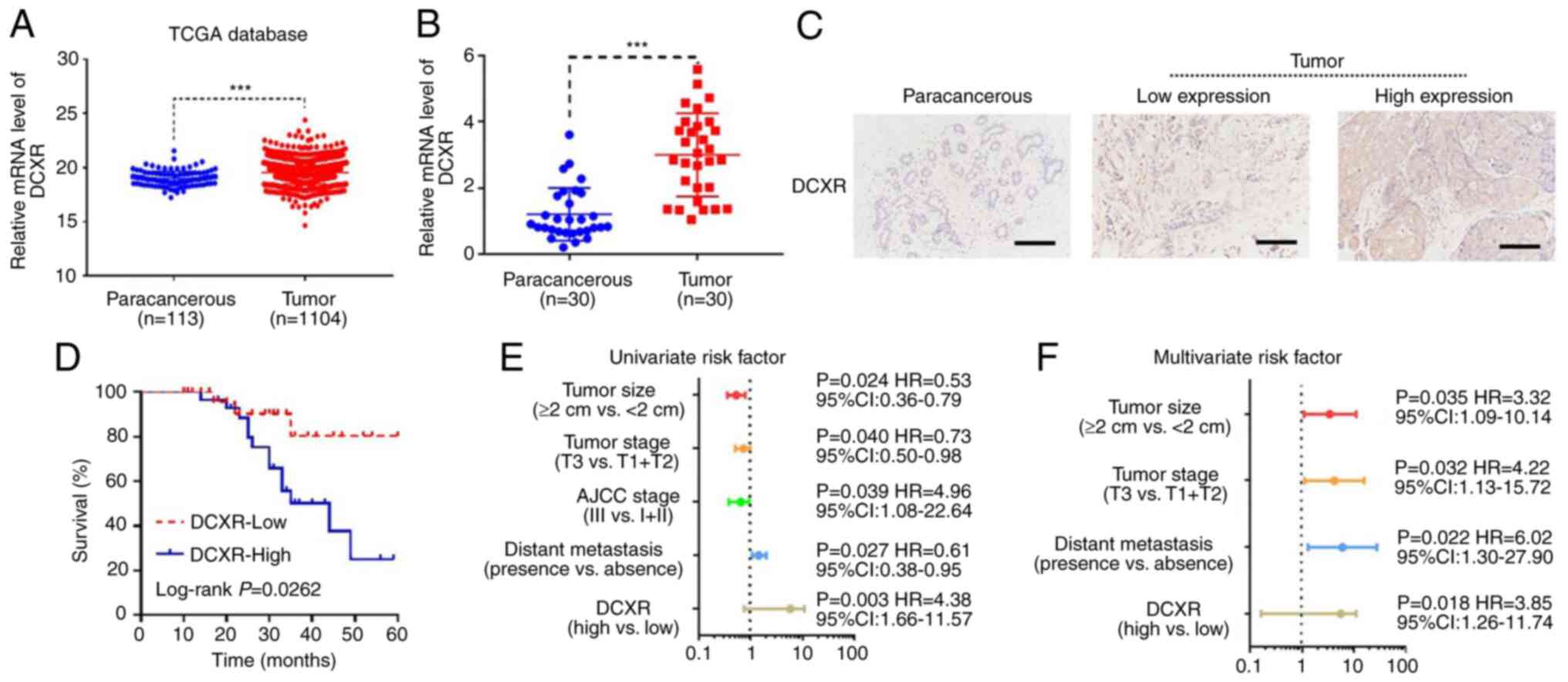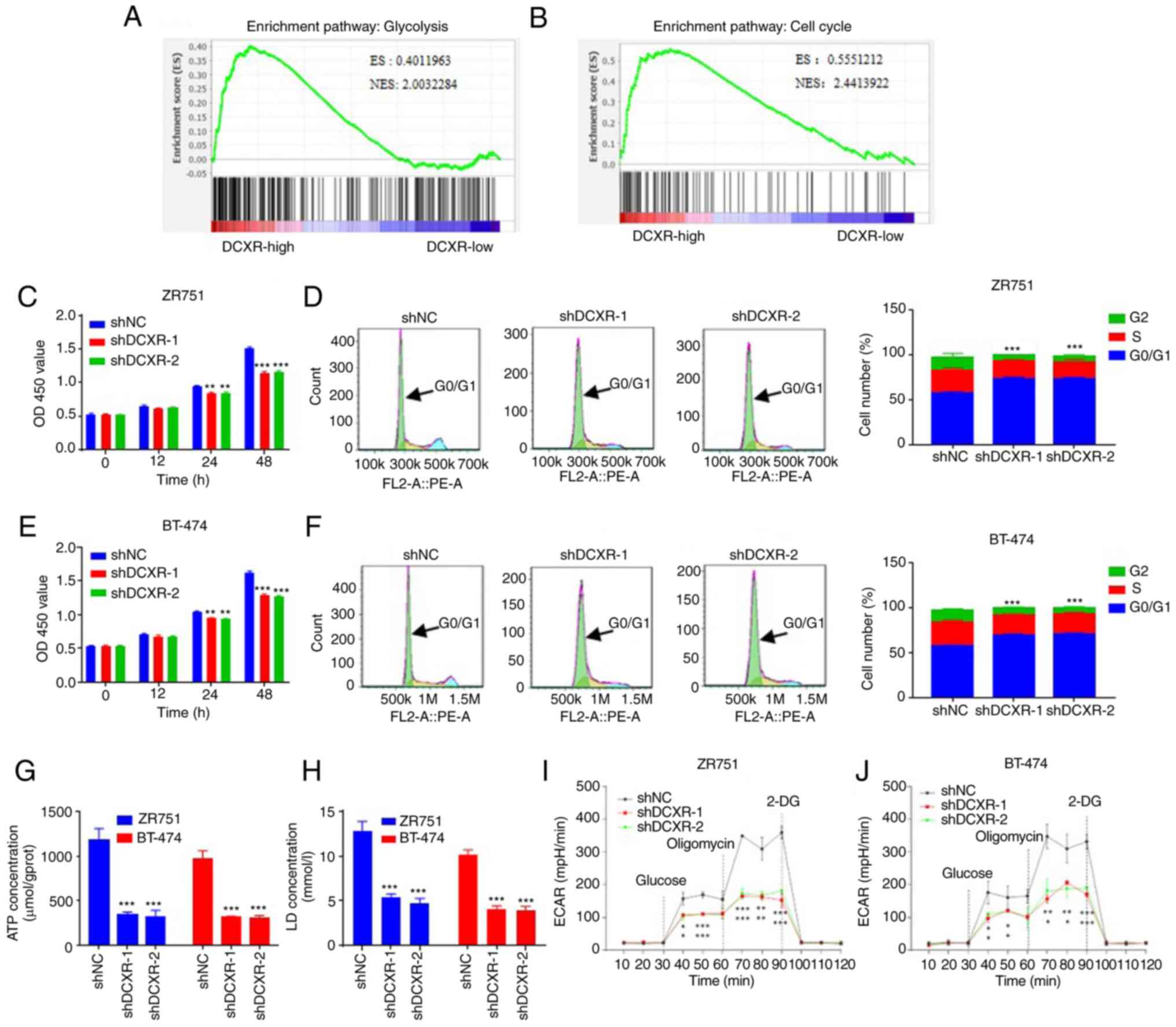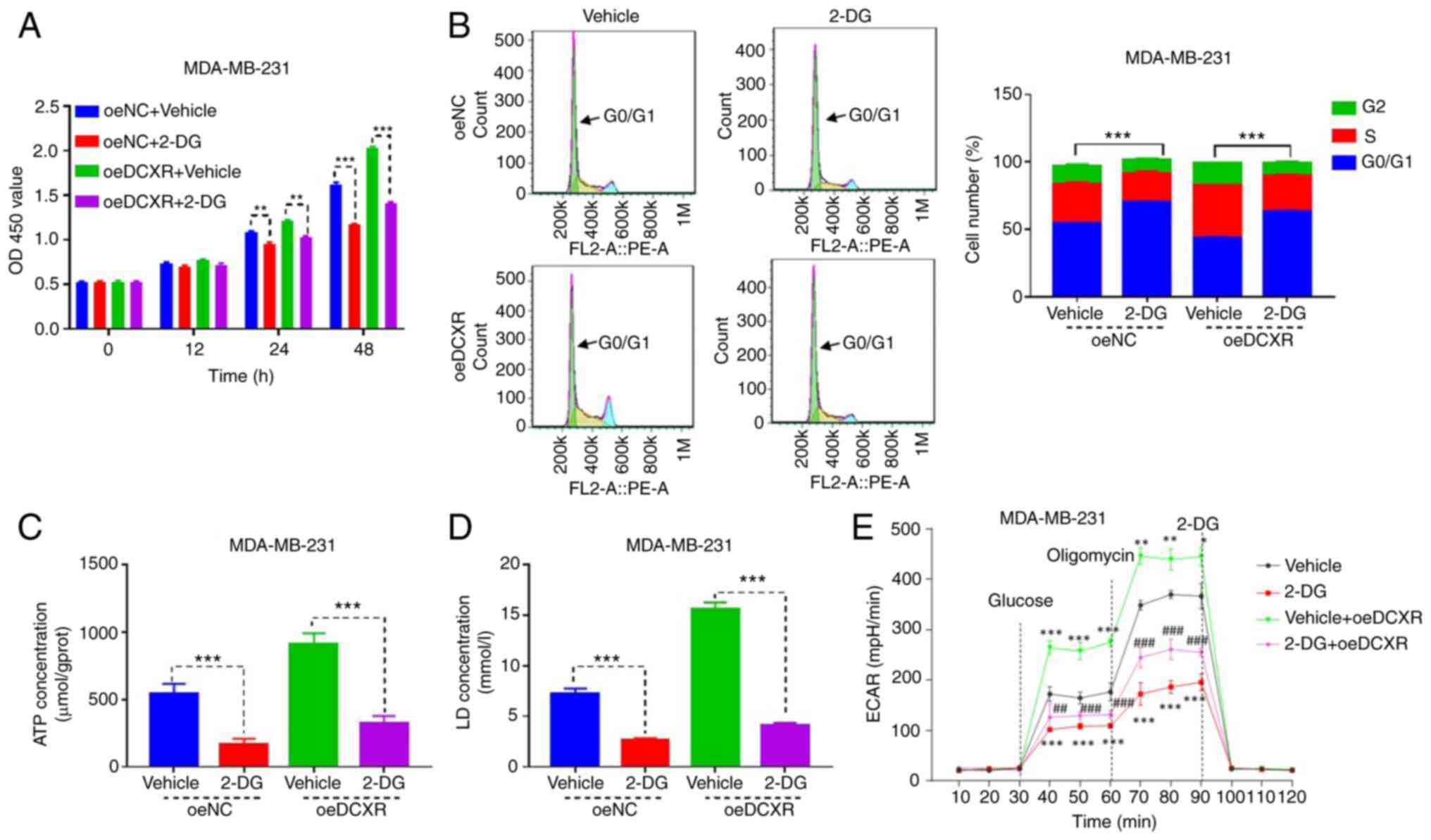|
1
|
Sung H, Ferlay J, Siegel RL, Laversanne M,
Soerjomataram I, Jemal A and Bray F: Global cancer statistics 2020:
GLOBOCAN estimates of incidence and mortality worldwide for 36
cancers in 185 countries. CA Cancer J Clin. 71:209–249. 2021.
View Article : Google Scholar : PubMed/NCBI
|
|
2
|
Solanki M and Visscher D: Pathology of
breast cancer in the last half century. Hum Pathol. 95:137–148.
2020. View Article : Google Scholar : PubMed/NCBI
|
|
3
|
Wang HX and Gires O: Tumor-derived
extracellular vesicles in breast cancer: From bench to bedside.
Cancer Lett. 460:54–64. 2019. View Article : Google Scholar : PubMed/NCBI
|
|
4
|
Tsang JYS and Tse GM: Molecular
classification of breast cancer. Adv Anat Pathol. 27:27–35. 2020.
View Article : Google Scholar : PubMed/NCBI
|
|
5
|
Kandel A, Dhillon SK, Prabaharan CB,
Hisham SFB, Rajamanickam K, Napper S, Chidambaram SB, Essa MM, Yang
J and Sakharkar MK: Identifying kinase targets of PPARgamma in
human breast cancer. J Drug Target. 29:660–668. 2021. View Article : Google Scholar : PubMed/NCBI
|
|
6
|
Rossi FA, Steinberg JH, Roitberg EH, Joshi
MU, Pandey A, Abba MC, Dufrusine B, Buglioni S, Laurenzi VD, Sala
G, et al: USP19 modulates cancer cell migration and invasion and
acts as a novel prognostic marker in patients with early breast
cancer. Oncogenesis. 10:282021. View Article : Google Scholar : PubMed/NCBI
|
|
7
|
Wang YP and Lei QY: Perspectives of
reprogramming breast cancer metabolism. Adv Exp Med Biol.
1026:217–232. 2017. View Article : Google Scholar : PubMed/NCBI
|
|
8
|
Wu Z, Wu J, Zhao Q, Fu S and Jin J:
Emerging roles of aerobic glycolysis in breast cancer. Clin Transl
Oncol. 22:631–646. 2020. View Article : Google Scholar : PubMed/NCBI
|
|
9
|
Heiden MG, Cantley LC and Thompson CB:
Understanding the Warburg effect: The metabolic requirements of
cell proliferation. Science. 324:1029–1033. 2009. View Article : Google Scholar : PubMed/NCBI
|
|
10
|
Vaupel P, Schmidberger H and Mayer A: The
Warburg effect: Essential part of metabolic reprogramming and
central contributor to cancer progression. Int J Radiat Biol.
95:912–919. 2019. View Article : Google Scholar : PubMed/NCBI
|
|
11
|
Enzo E, Santinon G, Pocaterra A, Aragona
M, Bresolin S, Forcato M, Grifoni D, Pession A, Zanconato F, Guzzo
G, et al: Aerobic glycolysis tunes YAP/TAZ transcriptional
activity. EMBO J. 34:1349–1370. 2015. View Article : Google Scholar : PubMed/NCBI
|
|
12
|
Zhao Y, He J, Yang L, Luo Q and Liu Z:
Histone deacetylase-3 modification of MicroRNA-31 promotes cell
proliferation and aerobic glycolysis in breast cancer and is
predictive of poor prognosis. J Breast Cancer. 21:112–123. 2018.
View Article : Google Scholar : PubMed/NCBI
|
|
13
|
Zhang HS, Du GY, Zhang ZG, Zhou Z, Sun HL,
Yu XY, Shi YT, Xiong DN, Li H and Huang YH: NRF2 facilitates breast
cancer cell growth via HIF1a-mediated metabolic reprogramming. Int
J Biochem Cell Biol. 95:85–92. 2018. View Article : Google Scholar : PubMed/NCBI
|
|
14
|
van Weverwijk A, Koundouros N, Iravani M,
Ashenden M, Gao Q, Poulogiannis G, Jungwirth U and Isacke CM:
Metabolic adaptability in metastatic breast cancer by
AKR1B10-dependent balancing of glycolysis and fatty acid oxidation.
Nat Commun. 10:26982019. View Article : Google Scholar : PubMed/NCBI
|
|
15
|
Perco P, Ju W, Kerschbaum J, Leierer J,
Menon R, Zhu C, Kretzler M, Mayer G and Rudnicki M; Nephrotic
Syndrome Study Network (NEPTUNE), : Identification of dicarbonyl
and L-xylulose reductase as a therapeutic target in human chronic
kidney disease. JCI Insight. 4:e1281202019. View Article : Google Scholar : PubMed/NCBI
|
|
16
|
Hu XH, Ding LY, Huang WX, Yang XM, Xie F,
Xu M and Yu L: (−)-Epigallocatechin-3-gallate, a potential
inhibitor to human dicarbonyl/L-xylulose reductase. J Biochem.
154:167–175. 2013. View Article : Google Scholar : PubMed/NCBI
|
|
17
|
Yang S, Jan YH, Mishin V, Heck DE, Laskin
DL and Laskin JD: Diacetyl/l-xylulose reductase mediates chemical
redox cycling in lung epithelial cells. Chem Res Toxicol.
30:1406–1418. 2017. View Article : Google Scholar : PubMed/NCBI
|
|
18
|
Ebert B, Kisiela M and Maser E: Human
DCXR-another ‘moonlighting protein’ involved in sugar metabolism,
carbonyl detoxification, cell adhesion and male fertility? Biol Rev
Camb Philos Soc. 90:254–278. 2015. View Article : Google Scholar : PubMed/NCBI
|
|
19
|
Jeffery CJ: Moonlighting proteins: Old
proteins learning new tricks. Trends Genet. 19:415–417. 2003.
View Article : Google Scholar : PubMed/NCBI
|
|
20
|
Cho-Vega JH, Tsavachidis S, Do KA,
Nakagawa J, Medeiros LJ and McDonnell TJ: Dicarbonyl/L-xylulose
reductase: A potential biomarker identified by laser-capture
microdissection-micro serial analysis of gene expression of human
prostate adenocarcinoma. Cancer Epidemiol Biomarkers Prev.
16:2615–2622. 2007. View Article : Google Scholar : PubMed/NCBI
|
|
21
|
Lee SK, Son LT, Choi HJ and Ahnn J:
Dicarbonyl/l-xylulose reductase (DCXR): The multifunctional
pentosuria enzyme. Int J Biochem Cell Biol. 45:2563–2567. 2013.
View Article : Google Scholar : PubMed/NCBI
|
|
22
|
Cho-Vega JH, Vega F, Schwartz MR and
Prieto VG: Expression of dicarbonyl/L-xylulose reductase (DCXR) in
human skin and melanocytic lesions: morphological studies
supporting cell adhesion function of DCXR. J Cutan Pathol.
34:535–542. 2007. View Article : Google Scholar : PubMed/NCBI
|
|
23
|
Hang X, Wu Z, Chu K, Yu G, Peng H, Xin H,
Miao X, Wang J and Xu W: Low expression of DCXR protein indicates a
poor prognosis for hepatocellular carcinoma patients. Tumour Biol.
37:15079–15085. 2016. View Article : Google Scholar : PubMed/NCBI
|
|
24
|
Xu J, Qin S, Yi Y, Gao H, Liu X, Ma F and
Guan M: Delving into the heterogeneity of different breast cancer
subtypes and the prognostic models utilizing scRNA-Seq and Bulk
RNA-Seq. Int J Mol Sci. 23:99362022. View Article : Google Scholar : PubMed/NCBI
|
|
25
|
Livak KJ and Schmittgen TD: Analysis of
relative gene expression data using real-time quantitative PCR and
the 2(−Delta Delta C(T)) method. Methods. 25:402–408. 2001.
View Article : Google Scholar : PubMed/NCBI
|
|
26
|
Shi B, Xue M, Wang Y, Wang Y, Li D, Zhao X
and Li X: An improved method for increasing the efficiency of gene
transfection and transduction. Int J Physiol Pathophysiol
Pharmacol. 10:95–104. 2013.PubMed/NCBI
|
|
27
|
National Research Council (US) Committee
for the Update of the Guide for the Care and Use of Laboratory
Animals, . Guide for the Care and Use of Laboratory Animals. 8th
ed. Washington (DC): National Academies Press (US); 2011,
PubMed/NCBI
|
|
28
|
Penault-Llorca F and Radosevic-Robin N:
Ki67 assessment in breast cancer: An update. Pathology. 49:166–171.
2017. View Article : Google Scholar : PubMed/NCBI
|
|
29
|
Kim YN, Kim SH, Son LT, Ahnn J and Lee SK:
Dicarbonyl/L-xylulose reductase (DCXR) producing xylitol regulates
egg retention through osmolality control in Caenorhabditis elegans.
Anim Cells Syst (Seoul). 26:223–231. 2013. View Article : Google Scholar : PubMed/NCBI
|
|
30
|
Moskovtsev SI, Jarvi K, Legare C, Sullivan
R and Mullen JB: Epididymal P34H protein deficiency in men
evaluated for infertility. Fertil Steril. 88:1455–1457. 2007.
View Article : Google Scholar : PubMed/NCBI
|
|
31
|
Kim K, Zakharkin SO and Allison DB:
Expectations, validity, and reality in gene expression profiling. J
Clin Epidemiol. 63:950–959. 2010. View Article : Google Scholar : PubMed/NCBI
|
|
32
|
Icard P, Fournel L, Wu Z, Alifano M and
Lincet H: Interconnection between metabolism and cell cycle in
cancer. Trends Biochem Sci. 44:490–501. 2019. View Article : Google Scholar : PubMed/NCBI
|
|
33
|
Williams GH and Stoeber K: The cell cycle
and cancer. J Pathol. 226:352–364. 2012. View Article : Google Scholar : PubMed/NCBI
|
|
34
|
Salazar-Roa M and Malumbres M: Fueling the
cell division cycle. Trends Cell Biol. 27:69–81. 2017. View Article : Google Scholar : PubMed/NCBI
|
|
35
|
Abbaszadeh Z, Cesmeli S and Avci CB:
Crucial players in glycolysis: Cancer progress. Gene.
726:1441582020. View Article : Google Scholar : PubMed/NCBI
|
|
36
|
Li L, Liang Y, Kang L, Liu Y, Gao S, Chen
S, Li Y, You W, Dong Q, Hong T, et al: Transcriptional regulation
of the warburg effect in cancer by SIX1. Cancer Cell. 33:368–385.
e3672018. View Article : Google Scholar : PubMed/NCBI
|
|
37
|
Qiao L, Dong C and Ma B: UBE2T promotes
proliferation, invasion and glycolysis of breast cancer cells by
regualting the PI3K/AKT signaling pathway. J Recept Signal
Transduct Res. 42:151–159. 2021. View Article : Google Scholar : PubMed/NCBI
|


















